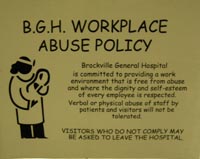Anyone interested in a microcosmic view of the state of healthcare in Canada can get a fairly good perspective by visiting Brockville General Hospital (BGH) in eastern Ontario. It isn’t the kind of place that one would go to if one were seeking medical treatment, but it would make a great case study in the intricacies of bureaucracy for anyone working on an MBA.
According to local sources, BGH recently received some $68 million in capital funding from the Ontario Ministry of Health and has begun an ambitious program of renovations designed to make the facility state-of-the-art. The first round of renovations started with the closing off of a number of the hospital’s patient wings and a complete renovation of the entrance and the business offices.
As a result BGH has more offices than it has patients’ rooms, a true necessity in modern single-payer healthcare. The emergency department at BGH is particularly interesting in that the triage nurse is usually sequestered within the confines of the treatment area, which is secured from the waiting area by doors that can only be opened from within and is demarcated by a wall of one-way glass so that patients and family are unable to see the nursing station inside. Patients enter and wait to be noticed. The registration desk does have a sliding window, again made of one-way glass that is attended by a surly clerk.
The changes in the hospital’s priorities haven’t exactly been met with enthusiastic endorsements by the citizens of Brockville, as is evident by the number of signs hung up all over the hospital’s corridors and waiting rooms reminding patients that rudeness or abuse of staff will not be tolerated and could result in being ejected from the hospital. I’m sure it’s a real morale builder for staff to have the full support of the hospital’s administration as they are dealing with people who are frightened and in pain having to routinely wait upward of seven hours or more for treatment.


For an experience that tests both the bounds of one’s dignity as well as one’s sanity, an extended stay at BGH is just what the doctor ordered. A friend’s mother recently suffered a stroke that resulted in one side of her body being permanently paralyzed and the prognosis is not good. Confined to BGH while waiting for an opening at a long-term care facility, this unfortunate woman spends her days gazing into the middle distance. Her diet consists of pureed foods, all of similar color and uniform lack of texture. In order to alter the type of food she is given the hospital requires doctors’ orders and a swallowing assessment, lest she choke on solid foods. Problem is the doctor is almost never available to recommend a change of diet and the individual that conducts swallowing assessments doesn’t actually work for the hospital, but is an itinerant employee of the Ministry of Health who is available on a limited basis. A change of diet can easily take upward of three weeks, as the hospital bureaucracy rolls out a plethora of ass-covering maneuvers, to ensure no one is to blame should the patient choke.
Any attempt to change or enhance the routine that governs my friend’s mother is met by hard skepticism and resistance. Voice mail messages left with administrators go unanswered for weeks. Requests for information about the patient are denied due to “privacy regulations” and so it goes. At one point my friend, who is her mother’s sole next of kin, asked the staff at BGH if privacy regulations permitted them to disclose whether or not her mother was still alive.
BGH is paid on the order of $999 per day to care for my friend’s mother and the hospital bills an additional $50 per day to the family (so much for ‘free’ healthcare). Total cost of care per month is in excess of $30,000 and the Ministry of Health just pays it. I would think for that kind of money one would get more than a drab room that doesn’t even have a phone (according to the hospital that’s an additional $150, per day).
BGH is a classic illustration of the direction in which healthcare in Canada is headed and if the hospital in your community hasn’t quite deteriorated to the level of BGH, just give it some time, as the healthcare bureaucracy is slowly but surely metastasizing into an insatiable behemoth that only exists for its own ends.
While under the current system healthcare in Canada may be ‘free’; the outcome in many cases doesn’t justify the cost. But it’s also illustrative of how Canada’s soviet-style healthcare system views patients. While we never tire of the trite and specious negative comparisons to the American healthcare model, Canada’s single payer system views the patient as a drain on resources, whereas that much-vilified US-style healthcare system views patients as customers… and treats them accordingly.
The signs on the wall at BGH admonishing hospital visitors not to abuse staff amount to treating the symptoms that plague the healthcare system. I suppose it’s a lot less work to print up a bunch of signs than to fix a healthcare system near total collapse.
Source

No comments:
Post a Comment